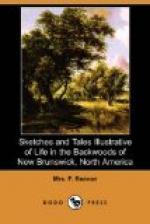he has found time to plant a few fruit trees, and
has now a flourishing young orchard, and a garden
wherein are herbs of “fragrant smell and spicy
taste,” to give a warm relish to the night’s
repast. For the cultivation of a garden the natives,
unless the more opulent of them, seem to care little;
and outside the dwelling of a blue nose there is little
to be seen, unless it be a cucumber bed among the
chips, or a patch of Indian corn. Again, the
Scotch settlers may be known by the taste shown in
selecting a garden spot—a gentle declivity,
sloping to a silvery stream, by which stand a few
household trees that he has permitted to remain—beneath
them a seat is placed, and in some cherished spot,
watched over with the tenderest care, is an exotic
sprig of heath or broom. About the Hibernian’s
dwelling may be a mixture of all these differing tastes,
while perhaps a little of the national ingenuity may
be displayed in a broken window, repaired with an
old hat, or an approximation towards friendliness
between the domestic animals and the inmates.
With the interior of these dwellings one is agreeably
surprised, they (that is, generally speaking), appear
so clean and comfortable. Outside the logs are
merely hewed flat, and the interstices filled up with
moss and clay, the roof and ends being patched up
with boards and bark, or anything to keep out the
cold. They certainly look rough enough, but within
they are ceiled above and around with smooth shining
boards; there are no walls daubed with white-wash,
nor floors strewn with vile gritty sand, which last
certainly requires all the sanctity of custom to render
it endurable, but the walls and floors are as bright
and clean as the scrubbing-brush and plenty of soap
can make them. This great accessary to cleanliness,
soap, is made at home in large quantities, the
ashes of the wood burnt in the fire-place making the
“ley,” to which is added the coarser fat
and grease of the animals used for home consumption.
It costs nothing but the trouble of making, and the
art is little. As regards cleanliness, the natives
have something almost Jewish in their personal observances
of it as well as of their food. The blood of no
animal is ever used, but flows to the earth from whence
it sprung, and the poorest of them perform their ablutions
before eating with oriental exactness; these habits
are soon imparted to the emigrants, many of whom,
when they first come out, all softly be it said, are
by no means so nice.
The large bright fires of the log house prevent all possible ideas of damp; they certainly are most delightful—those magnificent winter fires of New Brunswick—so brilliant, so cheerful, and so warm—the charred coals, like a mass of burning rubies, giving out their heat beneath, while between the huge “back-log” and “fore-stick,” the bright flames dance merrily up the wide chimney. I have often heard people fancy a wood fire as always snapping and sparkling in your face, or green and smoky, chilling




